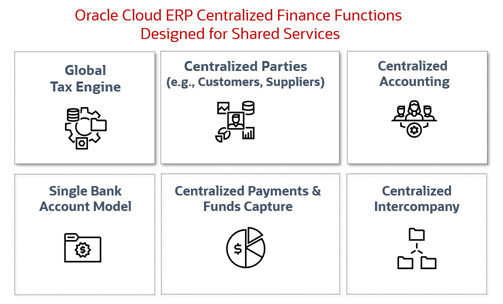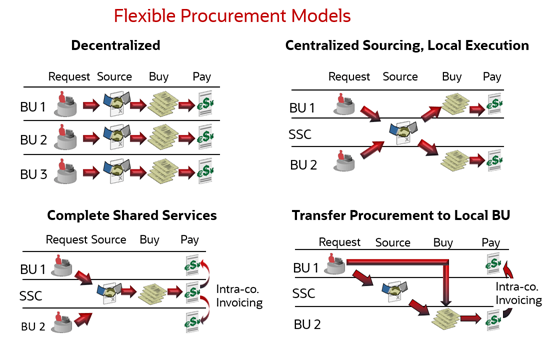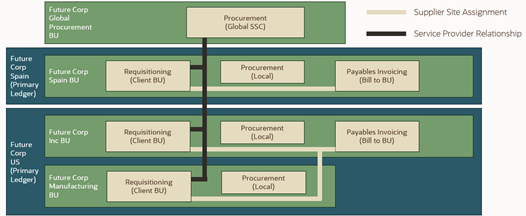A shared service center centralizes the management for selected business functions of enterprise entities.
The objective of a shared service center is to:
- implement standard business practices for consistency across the entire enterprise and conformity to corporate objective
- reduce and consolidate the number of control points and variations in processes to mitigate the risk of errors
- establish global processes and accessibility to data to improve managerial reporting and analysis
- establish the correct balance of centralized and decentralized functions to improve decision making
- automate processes to reduce administrative costs
Many multinational enterprises use regional shared service centers (SSCs) to deliver timely and local business support. SSCs standardize and consolidate business functions or processes. Service level agreements steer SSCs and the business to improve standardization, automation, and cost control.
This blog post focuses on how Oracle Cloud ERP supports shared service center objectives.
Uptake Quarterly Innovation to Drive Continuous Improvement
Oracle Cloud ERP delivers continuous innovation through quarterly updates.
As market challenges and opportunities arise, we enhance the applications to include relevant features. The blog post Harness The Business Value of Quarterly Updates explains our innovation process. Typically, a central team in an enterprise reviews the quarterly innovations. The central team collaborates with the SSC to identify business process areas to further automate or improve. New feature training is easily deployed to a SSC team with centralized procedures and processes in mind.
In 22B to 22D quarterly updates contains examples of features where you can achieve productivity gains for the Payables business process, such as:
- Payables: Intelligent defaulting of accounting information for no-PO invoice lines. This feature uses Al and machine learning algorithms. It predicts and defaults segment values of the account code combination on invoice line distributions. You can thereby reduce invoice entry time and accelerate the invoice to payment process.
- Intelligent Document Recognition for supplier invoice processing enhancements. Share adaptive learning between environments. Execute adaptive learning at invoice line level and for routing attributes. You can thus improve invoice recognition rates and reduce manual interventions.
Centralize and Standardize to Improve Data Quality and Reporting
A single Oracle Cloud instance helps SSCs standardize business processes and financial and management reporting. It facilitates sharing of setups, reports, and analytics across ledgers and business units. Sharing of setups reduces maintenance effort and minimizes the risk of discrepancies.
Introduce a corporate chart of accounts to standardize your financial data across your world-wide operations. SSCs can then process financial data and classify account balances uniformly through the corporate COA. Achieve corporate wide financial insight throughout the month, even before period close.
Oracle Cloud ERP centralized finance functions support SSCs in their drive for standardization.
Standardized business processes across multiple business functions enables SSCs to implement business processes once, and not multiple times.
With Oracle Cloud ERP SSCs can centrally:
- manage transaction taxes across processes with the global tax engine. It facilitates both sharing and segregation of tax configurations, such as country tax regimes. Once configured successfully, it ensures delivery of consistent tax services to all subledgers.
- create customer and supplier master records once. Use these for transaction processes across order-to-cash and procure-to-pay subledgers.
- maintain multiple accounting representations through the centralized subledger accounting engine to standardize accounting policies. Define accounting rules once, such as US GAAP and local country regulatory rules. Apply rules in a consistent and controlled way across subledgers with a complete audit trail.
- manage internal bank accounts through a single unified bank account model for use by multiple Oracle Cloud Applications.
- manage all funds disbursements and receipts efficiently across business units and legal entities with the centralized payments engine. It’s highly configurable and supports straight-through payment processing based on industry-standard protocols.
- set up intercompany for creation of intercompany invoices and automating intercompany balancing journal entries. Blog post Ease Journals Partition and Reporting with Correct Legal Entity Design includes a topic on how to generate automatic intercompany accounting entries.

Shared service centers may
- consolidate business processes – for example, establish a common period close procedure.
- consolidate reference data – for example, a common corporate chart of accounts.
- consolidate transaction processes – for example, a single supplier payment batch that includes invoices for multiple internal legal or management entities.
Improve Purchasing Power and Cost Control through Flexible Procurement Models
Procurement offers the potential for consolidating much of the organization’s spending. By consolidating spending power, centralized procurement can dramatically improve the terms and conditions of trade. It drives the business to the best performing suppliers along with the power to negotiate on price.
Oracle Cloud ERP supports procurement organizations with flexible procurement models.
You can decide on whether you want:
- a completely decentralized procurement function where your local regions source, buy, and pay for their own goods and services.
- a hybrid organization structure where you apply centralized sourcing with decentralized buying and payments.
- a dedicated shared service center buying and paying on behalf of your business units.

In almost all companies with a centralized global or regional procurement function for strategic purchases, many purchases are also managed locally.
A business unit with the Procurement business function is responsible for supplier negotiations, supplier site maintenance and purchase order processing. A Procurement business unit could, for example, represent a global shared service center that administers purchase agreements with strategic suppliers.
In Figure 3 the global procurement business unit is standalone. It has not been assigned any other business functions and has not been linked to a primary ledger.
- In this example, the global centralized shared service center is the service provider. The SSC manages supplier negotiations to control costs. It manages supplier site maintenance, and purchase order processing.
- At a global or regional level direct procurement is usually centralized. For example, purchasing paper for a book publisher or sand for a glass manufacturer. Professional SSC members of the procurement department most commonly raise direct procurement requisitions.
- However, at a local level at least some indirect procurement is managed, such as catering services for local events. Self-service non-professional users usually raise indirect procurement requisitions.
- Procurement business unit (BU) is linked via the supplier site assignment.
- A regional SSC processes Payables invoices on behalf of two BUs within the same ledger in the US.

Automate Supplier Invoice Process to Minimize Manual Data Entry
You can, through supplier invoice automation, minimize manual data entry and focus on exception handling.
You can automate supplier invoice creation in Oracle Cloud ERP in many different ways:
- Electronic invoicing: Use Oracle Fusion Payables inbound flow to receive invoices from suppliers electronically in industry standard XML. Implement Oracle Fusion Collaboration Messaging Framework (CMK) to set up business to business (B2B) messaging to receive invoices from your suppliers.
- Supplier Portal: Use Supplier Portal as a collaborative application with your suppliers. They will create invoices through the manage invoices business process in the Supplier Portal.
- Intelligent Document Recognition (IDR): Use IDR to predict invoice information from emailed documents from suppliers. IDR creates invoices and imports them into Payables. Apply machine learning to improve recognition rate for supplier invoices over time.
- Payables Standard Invoice Import: Use the FBDI template for Import Payables Invoices process to create invoices from invoice records in the Oracle Fusion Payables open interface tables.
SSCs establish the procedure for optimal supplier invoice process to automate and minimize manual data intervention.
Increase SSC Productivity with Cross Business Unit Payments
In Oracle Cloud ERP, cross business unit relationships are always within the scope of a single ledger.
It supports two cross business unit scenarios:
- cross business unit supplier payments (explained in more detail with Figure 3 in this separate blog post)
- cross business unit customer payments (explained in more detail with Figure 4 in this separate blog post)
SSC staff can access data for different business units. SSC staff can act on behalf of one business unit to perform services for others business units, such as paying an invoice.
This helps SSCs efficiently process payments. They can initiate a single payment run that spans multiple business units, currencies, payment methods, and bank accounts.
Secure Data Access and Reporting
In Oracle Cloud Applications, functions (for example, approve invoice, issue payment, etc.) are assigned to roles that are, in turn, assigned to users.
Oracle Cloud ERP offers the following mechanisms to secure transactions, journals, and balances:
- by business unit for subledger transactions (for example, requisitions, invoices, payments, etc.)
- by asset book for assets
- by ledger and primary balancing segment via data access sets (DAS) and segment value security for General Ledger (GL) balances and journal entries
- by folder security for Financial, Oracle Transactional Business Intelligence (OTBI) and Business Intelligence Publisher (BIP)
For instance, a Shared Services accountant for EMEA accesses data for companies based in EMEA only. You can control and secure such access through the above mechanisms.
Conclusion
Oracle Cloud ERP centralized finance functions deliver configurable setup to address transaction taxes, intercompany, and multiple accounting standard requirements. Automated high-volume invoice processes, and cross business unit payments speed up processes and reduce cost. These capabilities enable SSCs to drive quality, productivity gains, and cost control.
Gain more insight into Oracle Cloud ERP configuration via My Oracle Support Doc ID 2415848.1 on Cloud ERP Enterprise Structures.
